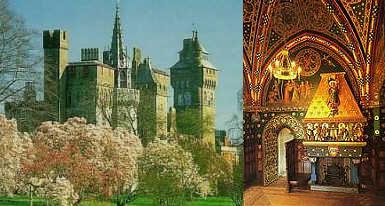|

Accendo
Music from the time of Claudio Monteverdi
at a concert in Cardiff Castle, Wales,
reviewed by REX HARLEY
There was a pleasant paradox in the fact that this concert, on 'authentic'
instruments, took place in the Banqueting Hall of Cardiff Castle, surely
one of the most 'inauthentic' surroundings it would be possible to
find. The Castle was reconstructed in the late Nineteenth Century for the
Marquis of Bute, under the direction of William Burges, and the Banqueting
Hall, an over-decorated and gilded confection, is to Gothic what the buildings
of the Third Reich were to Classical architecture: a monument to bad taste
and megalomania. The knights in armour striding around the mural, which
takes up three sides of this long room, might have stepped out of Ivanhoe,
or, for those with long memories, a packet of Kellogs cereal in the
early 1960s. And the whole thing is lit by three huge brass chandeliers,
stuffed with bright white megawatt bulbs.

Views of Cardiff Castle - exterior in Spring, and the Winter smoking room
|
Fortunately, the English Cornett and Sackbut Ensemble evinced rather
more subtlety than the room they were playing in, though it took them a
while to get going.
The earlier pieces in the recital suffered from a cautious approach,
possibly the result of lack of rehearsal of relatively recent repertoire.
At all events, the players' effort seemed to be going at least as much
into control as into expression. As a result, the music sounded, at best,
rather 'four-square', and there were moments of uncertainty, both
in terms of notes and timing. Not that this is easy music to play: far from
it. But the ensemble was not playing effectively as an ensemble.
That they could do so was finally demonstrated in Palestrina's Ascendo
ad Patrum, a piece at least as challenging as those which had preceded
it. Suddenly, there was a brightness and confidence, and one could really
enjoy the unique sound made by these two instruments. The sackbut is a more
restrained version of the modern trombone, with a narrower bell, originating
in the Fifteenth Century. Its partner, the cornett is to modern ears, and
eyes, a strange beast, made from wood, covered with leather and emitting
a sound quite unlike any other. Though serving the requirements of 'high
art', it retains some of the qualities of its ancestors: folk instruments
made from cow horns.
Continue >>
Copyright © 7 November 2002
Rex Harley, Cardiff, UK

|

